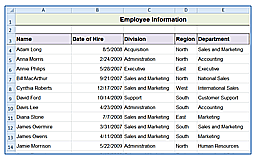All too often, we believe our Excel files are something they are not. An example of this is when someone instructs us to use an Excel template, but the file is actually a regular notebook. This can lead to disaster, especially if someone treats the file like an actual template and does not save it correctly, causing the workbook to be overwritten. Just as important is knowing how to save the file. If a workbook has macros, it must be saved as a “Macro-Enabled Workbook,” or the macros will no longer be included in future copies of the workbook, once it is overwritten. How do we tell the difference?
Luckily, we can look at the file icons to quickly identify the file types. Each icon has a unique identifier to help us ensure we save our files properly or keep our pre-configured workbooks from being overwritten. A regular workbook is easily overwritten, so care must be taken when saving this type of file. The icon looks like this:
![]() Note that this icon has a solid green strip at the top of the icon.
Note that this icon has a solid green strip at the top of the icon.
An Excel template will require a person to do a “save as,” regardless of clicking the save icon or doing an actual “save as” function, which keeps workbooks from being overwritten unless someone is purposely trying to overwrite a template. The icon for a template looks like this:
![]() Note that this icon has a solid green strip at the top of the icon.
Note that this icon has a solid green strip at the top of the icon.
Workbooks with macros require saving the workbook as “macro-enabled,” otherwise macros will no longer exist in the workbook. Ensuring the macro remains in the workbook can be even more important when various objects (buttons, etc.) have embedded VBA (Visual Basic Applications) macros that will cease to work if the file is saved as a regular workbook. The icon for a “macro-enabled workbook” lookslike this:
![]() Note that this icon includes a scroll with an exclamation point at the lower right side of the icon.
Note that this icon includes a scroll with an exclamation point at the lower right side of the icon.











